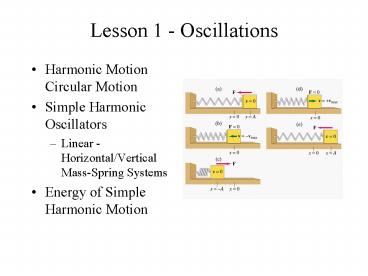Lesson 1 Oscillations PowerPoint PPT Presentation
1 / 24
Title: Lesson 1 Oscillations
1
Lesson 1 - Oscillations
- Harmonic Motion Circular Motion
- Simple Harmonic Oscillators
- Linear - Horizontal/Vertical Mass-Spring Systems
- Energy of Simple Harmonic Motion
2
Math Prereqs
3
Identities
4
Math Prereqs
Example
5
Harmonic
6
Relation to circular motion
7
Horizontal mass-spring
Frictionless
Hookes Law
8
Solutions to differential equations
- Guess a solution
- Plug the guess into the differential equation
- You will have to take a derivative or two
- Check to see if your solution works.
- Determine if there are any restrictions (required
conditions). - If the guess works, your guess is a solution, but
it might not be the only one. - Look at your constants and evaluate them using
initial conditions or boundary conditions.
9
Our guess
10
Definitions
- Amplitude - (A) Maximum value of the displacement
(radius of circular motion). Determined by
initial displacement and velocity. - Angular Frequency (Velocity) - (w) Time rate of
change of the phase. - Period - (T) Time for a particle/system to
complete one cycle. - Frequency - (f) The number of cycles or
oscillations completed in a period of time - Phase - (wt f) Time varying argument of the
trigonometric function. - Phase Constant - (f) Initial value of the phase.
Determined by initial displacement and velocity.
11
The restriction on the solution
12
The constant phase angle
13
Energy in the SHO
14
Average Energy in the SHO
15
Example
- A mass of 200 grams is connected to a light
spring that has a spring constant (k) of 5.0 N/m
and is free to oscillate on a horizontal,
frictionless surface. If the mass is displaced
5.0 cm from the rest position and released from
rest find - a) the period of its motion,
- b) the maximum speed and
- c) the maximum acceleration of the mass.
- d) the total energy
- e) the average kinetic energy
- f) the average potential energy
16
Damped Oscillations
Dashpot
Equation of Motion
Solution
17
(No Transcript)
18
Damped frequency oscillation
B - Critical damping () C - Over damped (gt)
19
Giancoli 14-55
- A 750 g block oscillates on the end of a spring
whose force constant is k 56.0 N/m. The mass
moves in a fluid which offers a resistive force F
-bv where b 0.162 N-s/m. - What is the period of the motion? What if there
had been no damping? - What is the fractional decrease in amplitude per
cycle? - Write the displacement as a function of time if
at t 0, x 0 and at t 1.00 s, x 0.120 m.
20
Forced vibrations
21
Resonance
Natural frequency
22
Quality (Q) value
- Q describes the sharpness of the resonance peak
- Low damping give a large Q
- High damping gives a small Q
- Q is inversely related to the fraction width of
the resonance peak at the half max amplitude
point.
23
Tacoma Narrows Bridge
24
Tacoma Narrows Bridge (short clip)

